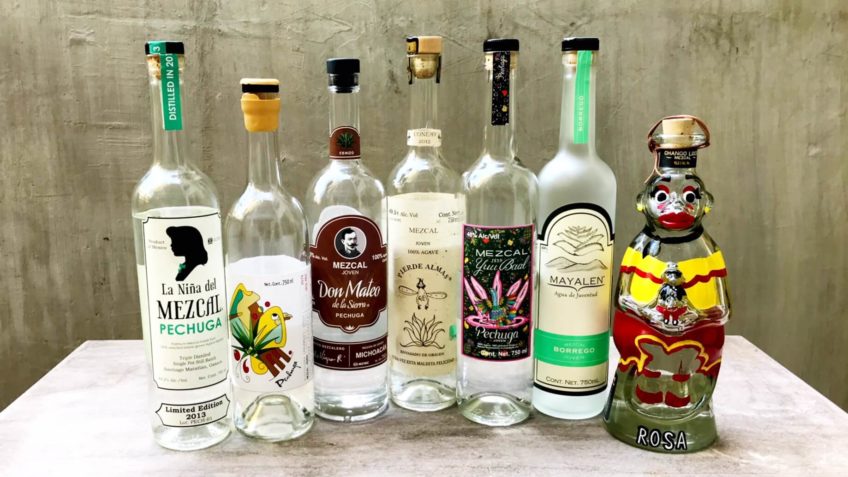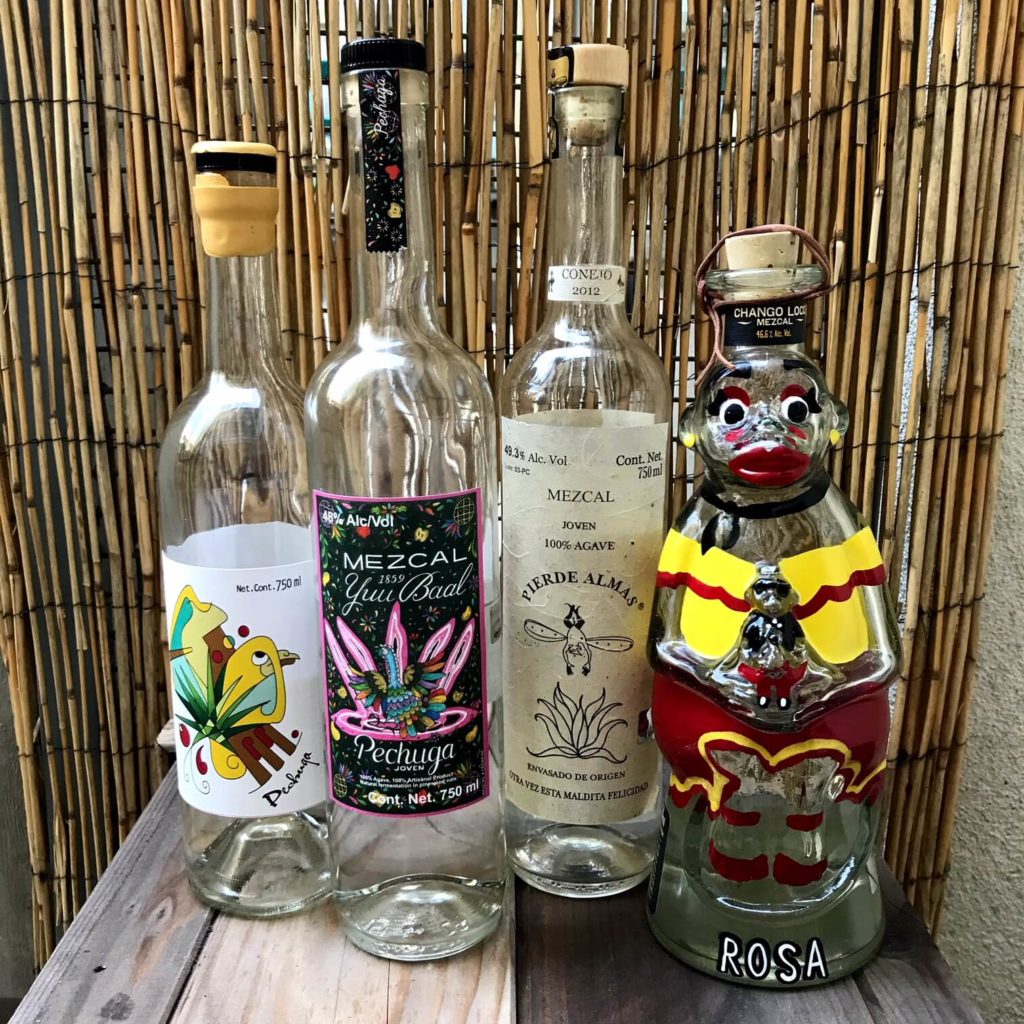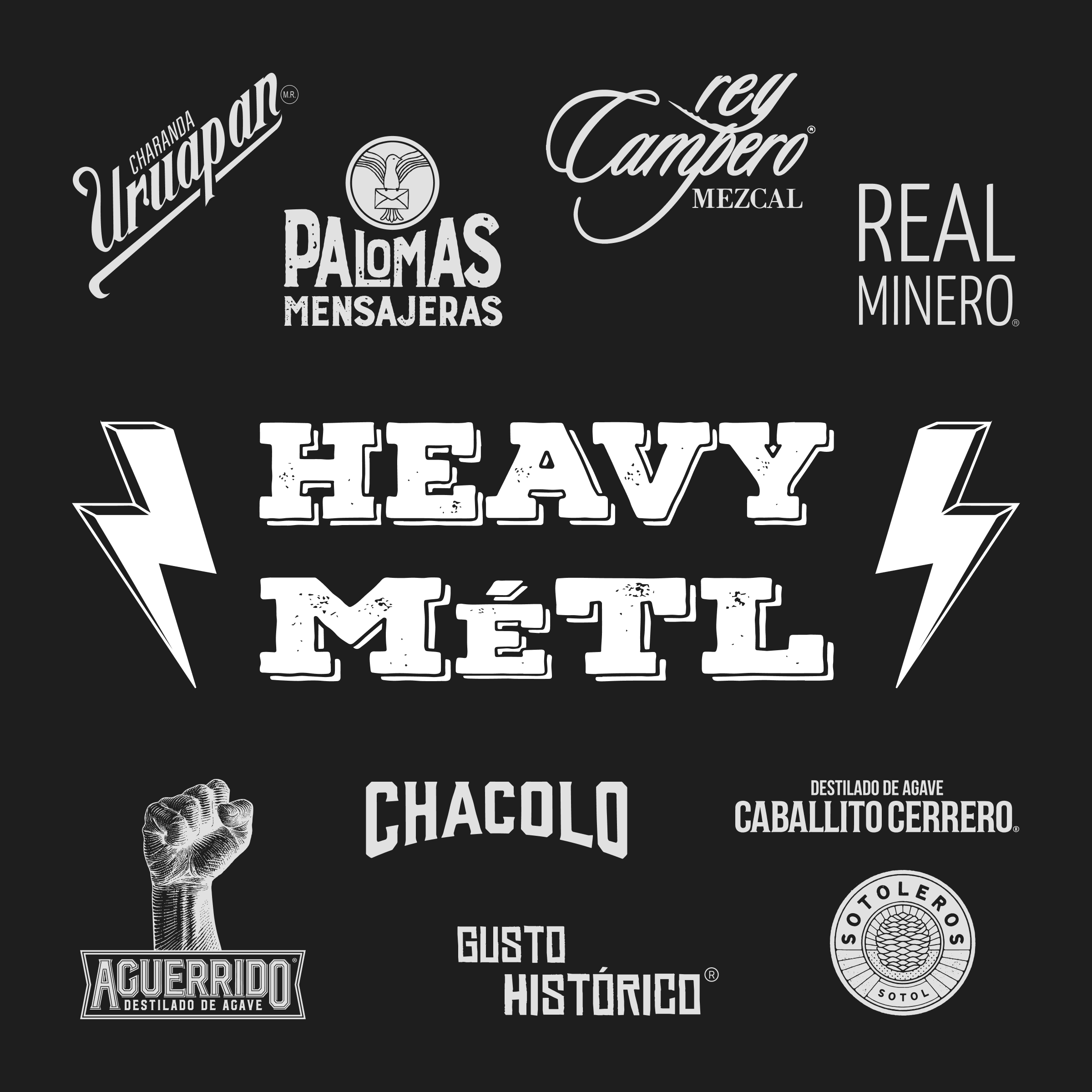Mezcal Reviews is on its third blind tasting and we’re not slowing down. The “research” must continue as I tell my girlfriend. Jonny and I are off to a strong start after doing blind tastings of agave Tepextate and then agave Tobala mezcals. This time, the agave species isn’t the theme but rather the style of mezcal: pechuga! While all the mezcals de pechugas we blind tasted were made with agave Espadin (which is most common), you can certainly find pechugas made with other agaves such as Cupreata or Cenizo. As far as I know, mezcal is the only spirit in the world that has a style produced using the “pechuga” process.
How can I set up a blind tasting? Read our first blind tasting blog for detailed instructions
What is mezcal de pechuga?
Any fan of mezcal can tell you that hearing about pechugas for the first time is an eye (or palate?) opening experience. Certain mezcalheads dislike pechugas but I think we can all agree it is a fascinating concept. What’s fascinating?? Well, most mezcals are twice distilled in copper or clay pots. Pechugas are typically distilled a third time with a special twist. For the third and final distillation, a raw chicken breast is hung inside the still. In addition to the chicken.. spices, fruits, and nuts are added into the bottom of the still with the agave mash. While this sounds a bit odd, it has been a practice for many generations. Traditionally, enjoying a mezcal de pechuga is reserved for special occasions like weddings, birthdays, and patron saint days. Now, exported pechugas are sold for top-dollar and produced by many brands. Certain pechugas are made in two distillations rather than three. Others use meats like turkey, lamb, rabbit, or even iguana instead of chicken. Pechugas introduce a wide array of flavors into an already complex spirit.
As you might guess, the flavors of a pechuga mezcal can vary greatly due to the ingredients used. Typically each village will have their own recipe using the local fruits, nuts, and spices available during harvest season. Producers would make a batch of pechuga once per year during harvest season using distilled agave Espadin. Hanging meat inside the still gets all the attention here, but the reason that is done is to prevent the fruits, spices, and nuts from overpowering the mezcal – the meat provides balance, it too should not dominate the flavor. This can be quite a challenge, as we learned from this tasting. Finding the right balance is key to a great pechuga.
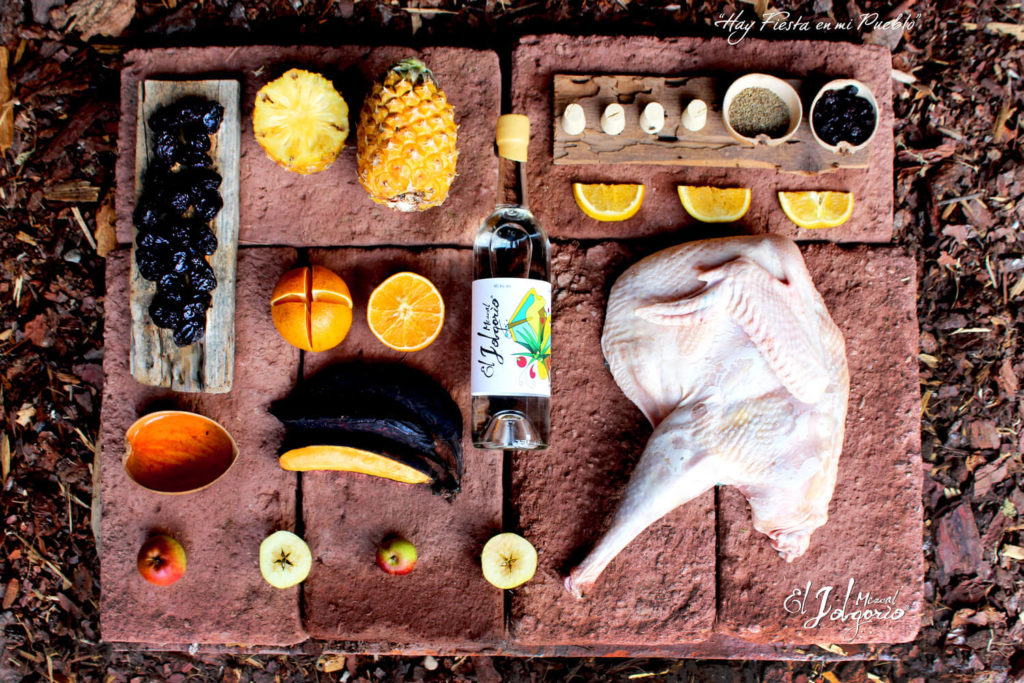
“It is important to note that, due to its purpose of celebrating important events, Pechuga is always intended to be shared among friends.” — from the El Jolgorio website
Blind tasting bottle lineup
| Mezcal | Mezcalero | Batch info | ABV% | Avg. Price ($USD) |
| Chango Loco | ? | Lot 101 | 46.6% | $120 |
| El Jolgorio | Ignacio Parada | Batch 3, 2014 | 47.5% | $140 |
| Tosba | Edgar Gonzalez Ramirez | Lot 6 | 46% | $90 |
| Real Minero | Don Lorenzo Angeles | Lot 1, 2014 | 51.7% | $170 |
| Pierde Almas Conejo | ? | Lot 3, 2012 | 49.3% | $199 |
| Pierde Almas | ? | Lot 4, 2012 | 49% | $180 |
| Yuu Baal | Martimiano Hernandez | YJ18-16 | 48% | $90 |
Since pechugas are generally made with agave espadin or other commonly harvested agaves, they are not necessarily hard to find in stores or online. Mezcals are often priced in relation to agave species rarity but this is not the case with pechugas. They are usually quite expensive for a different reason. The process of gathering the extra ingredients and completing a third distillation (which lowers yield), leads to an increased price for pechugas. For example, the Del Maguey Iberico pechuga is made with Iberico ham from Spain and can costs $200 a bottle! Some will argue that pechugas have become an overpriced novelty. We think you should give them a try – pechugas can also be a fun way to introduce people to mezcal.
Given the high price of pechugas, we pulled together our resources for this tasting.. and by “resources” I obviously mean our mezcal. We also recruited our friend Joseph, a fellow mezcalhead and Austin local, to join us. Joseph was a whisk(e)y fan for many years before getting into mezcal. Joseph is a professional Classical Guitarist and extremely talented. Earlier this year he organized a music and mezcal concert in the mountains of West Texas! Check out the awesome photos on Facebook. He has an incredibly refined palate and his mezcal reviews are expressive and detailed like his music. On that note, let’s get on with the tasting.
Here is the tasting in the blind order that we tried them:
Chango Loco
This clay pot distilled mezcal is called “Rosa” and comes in a painted monkey bottle which, according to the Chango Loco website, honors the 1930s tradition of storing mezcal in black clay Chango bottles. Each bottle of Chango Loco is hand-blown and painted (which likely increases the overall price). I’m a fan of the Chango Loco Juan, a madrecuishe, which is likely made by a different mezcalero. Jonny and I met a brand rep and were unable to get any detailed information about the mezcalero behind this pechuga which is unfortunate. Their bottles are a bit contentious and some bars and stores don’t put them on the shelves, but let’s focus on the juice.
“Anise, spice, and hints of candied fruit. Nice agave sweetness on front palate. Fairly viscous – feels/tastes like it might be clay-distilled. Mild gaminess. Lovely.” — Joseph
“Nose is piney and bright. Notes of brine and saltiness. Slightly meaty and well balanced. Somewhat candied with orange and lemon peel.” — Jonny
“Soft easy drinker. Bit of molasses, butterscotch, salted meat, and lemon lime sugar cubes.” — Tyler
Joseph nailed it with the clay pot guess (something we didn’t know at the time of the tasting). We all got a candied taste from this pechuga. I was surprised by how well this stacked up against the other pechugas in our lineup. There were only 329 bottles made in this lot. It is unknown if the Chango Loco brand will be working with the same producer and releasing more so try it while you can.
El Jolgorio
The pechuga from El Jolgorio is only twice-distilled. On the second distillation, locally harvested pineapple, orange, plantains, anise, and other ingredients are added. Instead of chicken, a raw guajolote (creole turkey rooster), is hung on the inside the still.
“Bright, reminds me of mountain air. Definitely a gamey and slightly funky quality. Total shift from the last one. Very unique.” — Joseph
“Tastes exactly like my grandfather’s grilled thanksgiving turkey. This is turkey heavy and very delicious. It’s super meaty.” — Jonny
“Gamey on the nose. Faint burnt butter, old coffee, nutty, soy, and muddled cranberries.” — Tyler
This pechuga is a fan favorite with friends. The turkey flavor is present but not overpowering. This pechuga was crafted by Ignacio Parada who makes a number of amazing mezcals for El Jolgorio. Take note, there are multiple mezcaleros producing a pechuga under the El Jolgorio label. The most recent release is in a black glass bottle.
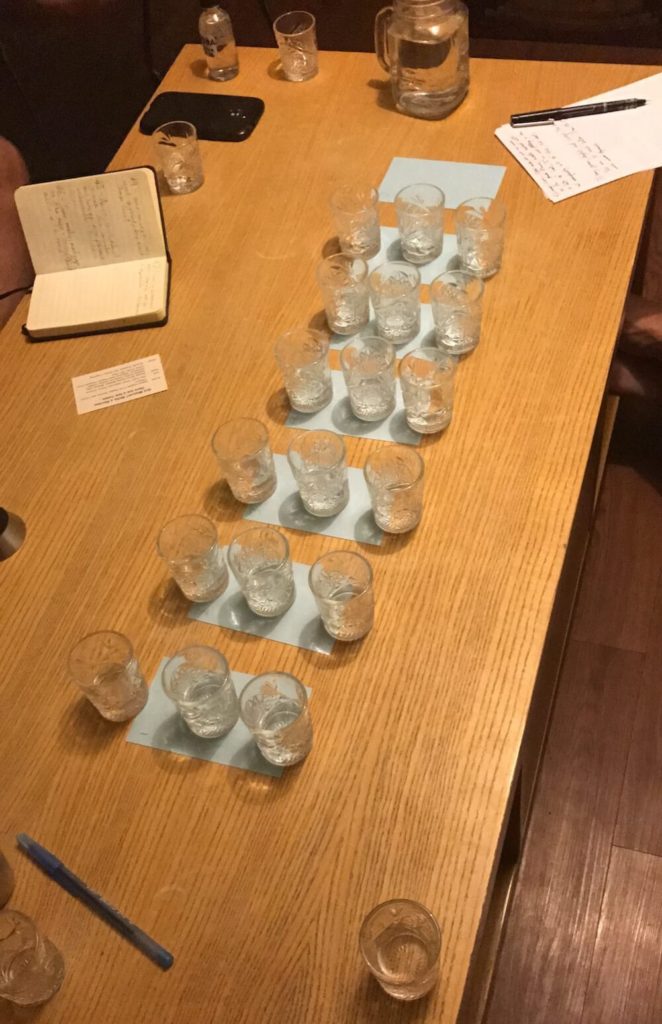
Line ’em up. If you take notes during a tasting, we recommend paper and pen over a cell phone.
Tosba
Here is one of the first pechugas we ever tried. Very few bottles made it to Texas and Jonny was able to get one last year. Tosba’s pechuga is made with a combination of wild pineapple, bananas, wild apples, rice, and a wild turkey breast.
“Pleasant sweetness. Balanced. Flavors are well integrated and carry throughout the palate. Subtle hints of vanilla, fruit, spice and a very mild gaminess, yet none of the individual flavors stand out distinctly, but it is quite good.” — Joseph
“VERY Different. Neither herbal nor meaty. Right down the middle with the same notes at start and finish. The taste just continues in a nice, pleasant sort of way.” — Jonny
“Honeyed sweetness, chocolate, really good but flavor is in the middle of the palate.” — Tyler
Tosba is a really exciting company and is now exporting four different mezcals: Espadin, Pechuga, Tobala, and Tepextate. The team at Tosba is planting thousands of agaves in San Cristobal Lachirioag for future mezcal.
Real Minero
This is a very special pechuga for us because Graciela Angeles of Mezcal Real Minero described gathering the ingredients for her late father at a local market when she was a child. As we sipped it in Mexico with her, she said it was Don Lorenzo’s favorite mezcal. This pechuga is made in Santa Catarina Minas and is a shared recipe in the region referred to as Gusto Histórico, or “historic taste”.
“Some anise and fruit notes. Viscous and lightly sweet up front with a long yet dry finish. Some nice musty/gaminess. Robust and full yet no polarizing flavors. Very good.” — Joseph
“Super complex. Slight fruit on the notes. Palate has strong meat AND spices. This heads in both directions simultaneously. It’s both sides of the pechuga at once: both herbal and meaty.” — Jonny
“Anise and spice, clove, a bit gamey, cherry lollipop, dark chocolate. Balanced. Really enjoyable.” — Tyler
We’ve heard the Del Maguey pechuga has nearly the same (if not the exact same) recipe as Real Minero given they are both produced in Minas. Of course, this doesn’t mean they end up tasting the same. We all enjoyed the pechuga from Real Minero for its balanced complexity.
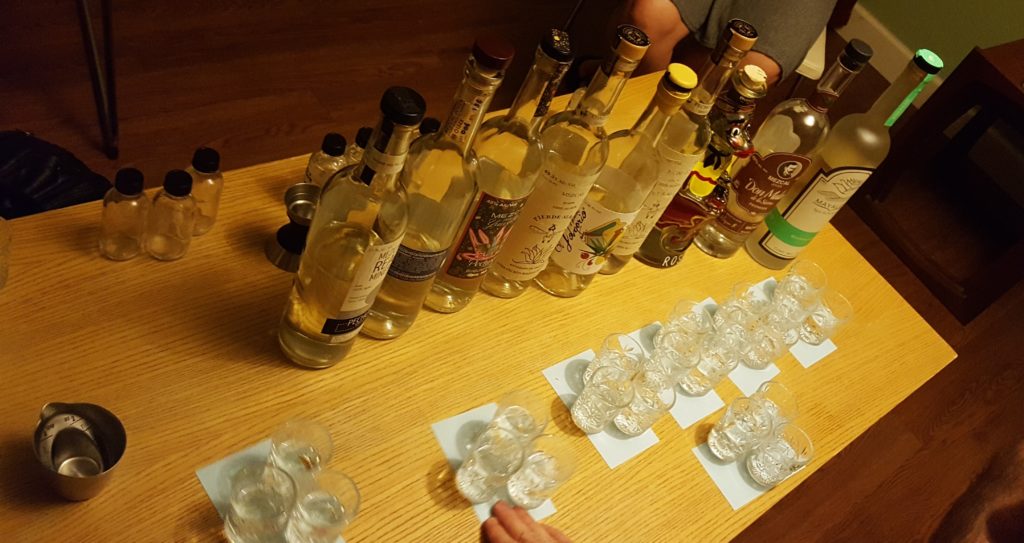
That’s a lot of meaty mezcal
Pierde Almas Conejo (Rabbit)
This rabbit pechuga has a lot of hype. Some people rave about it. A bottle will retail for around $200 and is hard to find. I even mentioned wanting to try this mezcal in a blog post last year. The search has finally ended. While we don’t know the name of the mezcalero (or mezcalera), this mezcal was produced in San Baltazar Chichicapam according to the label.
“Anise. Sweet, robust, and viscous. Anise dominates, but lots of subtle flavors if you can get underneath the anise. Fruit spice and more anise.” — Joseph
“Anise on the nose. Anise on the palate. This is all anise. Nothing but anise. Slightly viscous.” — Jonny
“Anise, thick mouthfeel, a bit hot, lemon honey tea, dried raisin” — Tyler
Anise! Unfortunately, this expensive and revered mezcal was probably the least favorite of the tasting. Perhaps the batch wasn’t the best, or it wasn’t stored well before I purchased it? Maybe the bottle needs to “open up”? I’m trying to be positive here. Thankfully I found the bottle for about half the normal price.
Pierde Almas (Turkey)
Unlike the rabbit, this Pierde Almas pechuga is made with turkey. It shared a lot of similar flavors.
“Some meaty/mustiness on the nose. Thick and viscous feel. Anise, spice, and fruit. Anise heavy (though not quite as much as last one).” — Joseph
“Slight anise on the nose, but not as much as the previous mezcal. Middle bodied with a bit of heat. I’m not getting a ton of complexity out of this.” — Jonny
“Upfront spearmint along with anise but not as much as the previous mezcal. Flavors of butterscotch and sour cherries. Light on the meat flavors with spices taking the forefront.” — Tyler
This version of the Pierde Almas pechuga was more enjoyable than the rabbit version. My guess is that these mezcals might vary quite a bit batch-to-batch. Given that we don’t know the mezcalero, they could be totally different. However, if I had to guess, both of these Pierde Almas mezcals were made by the some mezcalero with a similar recipe.
Yuu Baal
Yuu Baal is an interesting brand that has become well-stocked in “big box” liquor stores in Texas over the last year. That said, I could only find this pechuga in California. The Yuu Baal line of mezcals is crafted by different mezcaleros. The artwork on their bottles is very simple with their pechuga being the exception – there is an elaborate technicolor drawing of a wild turkey surrounded by fruits and flowers. We all enjoyed this one.
“Totally different nose – almost reminds me of a tepeztate. Herbaceous, bright, and vegetal. Nose is mostly mirrored on palate. Also has a nice citrusy quality. Mild yet detectable meatiness. Delicious.” — Joseph
“Very green, bright, and crisp. This one is much better than the previous two mezcals, much more dynamic. Fruity and rich. Thicker with hints of mint, meats, and fresh herbs.” — Jonny
“Spicy gravy, orange candy, fresh eucalyptus, hickory. A bit dark.” — Tyler
The Yuu Baal was a great place to finish and exceeded our expectations. This is the only mezcal being imported from Martimiano Hernandez and we’ll be on the lookout for more of his mezcals.
In conclusion
Once again, blind tastings generate many surprises. The Chango Loco Rosa was surprisingly good. It is disappointing that the brand doesn’t share more information about the mezcalero or even the town from where it was produced because we’d like to seek out more of this mezcal. The El Jolgorio stood out as the most uniquely tasty pechugas of this bunch. Real Minero’s pechuga was the most balanced and complex mezcal in our lineup. We all agreed that both of the Pierde Almas pechugas are a bit overpriced and underwhelming relative to others on the market. Even though our palates were quite worn out near the end of the tasting, the Yuu Baal surprised us as being very enjoyable and a great value.
While we couldn’t fit all the mezcals de pechuga into the tasting, be on the lookout for these other bottles:
- Del Maguey Pechuga
- Mayalen Borrego (made with agave Cupreata and lamb)
- Don Mateo Pechuga (made with agave Cenizo and venison)
- Vago Elote (no meat here, just toasted corn.. but it kind of counts)
Do you have a favorite pechuga mezcal? What kinds of occasions do you think call for mezcal de pechuga? Thanks for reading and stay tuned for our next blind tasting blog when we taste a selection of different agave Madrecuishe mezcals!


